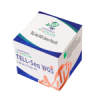The Sage Science R&D team has been hard at work on our newest tool, to be released later this year. The HLS platform, which we first described at the Festival of Genomics meeting in Boston last year, is our answer to the growing need to generate high molecular weight DNA fragments directly from blood or cell suspensions for long-range sequencing.
As the sequencing community shifts its focus from short-read to long-range information — from single molecule long reads or synthetic long reads — the pressure is on for sample prep processes to adjust accordingly. Sample prep pipelines that work for 200-base fragments simply can’t scale to handle 50 kb fragments. We believe that new approaches are needed to enable workflows with high molecular weight DNA, and that’s where the HLS platform comes in.
Here’s how it works: we load samples into a gel, where we perform cell lysis, enzyme processing, and contaminant removal. Thanks to electrophoresis, this all moves much faster than it would on a regular gel, and the megabase-scale DNA is large enough to be stuck in the agarose. After purification, the DNA is lightly cleaved, allowing it to be retrieved from the gel in an automated elution process.
To see how the HLS prototype performs, check out the technology overview or this poster describing an experiment with human cultured cells and goat whole blood. DNA fragments extracted with the HLS were often tens of kilobases, or even megabases, long.






